|
egy.com suggests following articles
|
|
Several of my articles on Garden City were plagiarized word for word by novelist MEKKAWI SAID (winner of the Egyptian State price for literature!!!!) and re-published under his own name in a three-part series in El-Masry El-Youm daily in September 2015. Cheers to our "talented" literature prize awardee. Your pain his gain !!!
|
EGY.COM - LANDMARKS - CAIRO - HELIOPOLIS
THE HELIOPOLIS PALACE HOTEL
a Desert Taj Mahal
Samir Raafat,
Cairo Times, 19 March 1998
Ahmed Mubarak of Egyptian daily al-Masry al-Youm plagiarized large parts of this article on 6 June 2010

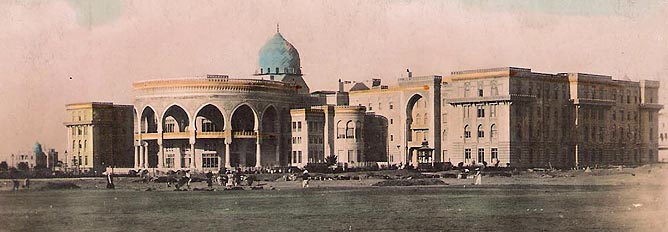
Heliopolis Palace Hotel turned into the Federation of Arab Republics headquarters in 1972 and later into an executive presidential palace during Mubarak's reign
Below: 1913 advertisement


share certificate courtesy Richard Bacos
Sixty years after Nasser's Free Officers vowed to turn this nation into a "by the people and for the people" democracy, Egypt's citizens remain as isolated from the temples of power just as they had been millenniums ago when Pharaohs ruled the land and high priests prohibited access inside holy sanctuaries reserved exclusively for the ruling caste. Today, except for a very few halls in Abdeen Palace, few Egyptians if any have seen the gilded interiors of the former royal palaces of Tahra, Koubbeh and Ras Al-Tin, and unless deferred plans to turn them into public historic are realized fat chance they ever will.
Not so Kasr Al-Ittihadiya, now perhaps the most august and restricted of them all. Save for national and international leaders and a sprinkle of accredited journalists who have restricted access, there are nevertheless some aging Egyptians who remember having frequented the building when it was the then-famous Heliopolis Palace Hotel.
The oldies will tell you how international conferences, weddings and honeymoons took place there, as did the coveted apres courses celebrations for the races at the nearby Heliopolis Sporting Club were second to none. Although veterans are probably not around anymore to remind us, during the First World War the hotel was requisitioned and turned into a British military hospital.
Just like Heliopolis itself, the grandiose Palace Hotel rose out of the desert wastes in 1908-10 in the days when lengthy sojourns in Egypt were a social ritual and Cairo hotel registers resembled pages from Burke's Peerage.
The Heliopolis Palace Hotel proprietor was a Monsieur Marquet from France or perhaps Belgium. As for its inaugural director Herr Doerhoefer, he had heretofore been with the Mena House overlooking the Giza Pyramids. The hotelís first food and beverage manager meanwhile was Monsieur Bedard, assisted by Chef Gouin. They had come from the Paillard Restaurant in Paris.
On 1 December 1910, all four were on hand to greet Egypt's best. They had come to celebrate the official launch of Africa's most luxurious hotel. Conceived by Belgian architect Ernest Jaspar, the hotel boasted 400 rooms including 55 private apartments. Its banquet halls were amongst the biggest anywhere. The utilities were the most modern of their day. All were constructed by the firms of Leon Rolin & Co and Padova, Dentamaro & Ferro, two leading civil contractors. As for the hotelís web of electric cables and installations, these were fitted and put together by Messrs Siemens & Schuepert of Berlin.
As though intentional the severe almost forbidding, hotel exterior contrasted sharply with the sumptuousness of the interior. A 1912 visitor recounts: "Beyond the reception offices are two lavishly decorated rooms in Louis XIV and Louis XV styles respectively, and then comes the central hall, which is a dream of beauty and symmetry. Here the architecture, which is responsible for so many wonderful effects in Heliopolis, reaches its artistic zenith. From every nook and cranny hang, suspended like stalactite pendants, Damascus-made Oriental lamps of fantastic loveliness."
To give us a sense of the central hall's monumental dimensions the overwhelmed visitor continues: "Above soars the dome rising upward in a bold scheme of frolicsome fancy with all the involved convulsions of Oriental ornamentation. No photograph or description could do justice to the wondrous and elusive loveliness of the scene, which is baffling to the language as it is to the lens."
"C'est une merveille!" exclaimed the King of Belgium in 1911 when he entered the main hall accompanied by his consort. The royal couple spent an entire month at the Heliopolis Palace Hotel, during which time Queen Elizabeth, who was recovering from typhoid, slowly regained her health. The dry air of Heliopolis had been strongly recommended by her doctors in Brussels.
Another king was equally taken by the hotel, so much so that before his wife died in 1915 she urged him to build a hotel "Like the great Heliopolis Hotel in Cairo." As Milton S Hershey finally prepared to construct his hotel in Pennsylvania, he contacted the architect of the Heliopolis Hotel and arranged to purchase his plans. But when it was estimated that the cost of duplicating the structure would be $5 million, America's chocolate king abandoned the idea.
A regular visitor to Egypt of that period, who couldn't believe his eyes upon visiting Heliopolis, was John Pierpont Morgan. Never before had the legendary tycoon seen architectural cross-fertilization of such magnitude. The overall scene was so phantasmic he exclaimed in zest that the Heliopolis Company directors should be arrested for having conceived such a mind-boggling endeavor! And that Taj Mahal by the desert ... was it real? JP Morgan was in a tizzy!
The Heliopolis Palace Hotel's main dome that was so awe inspiring to monarchs and tycoons alike measured 55 meters from floor to ceiling. The 589 square meter hall, designed by Alexander Marcel of the French Institute and decorated by Georges-Louis Claude, was carpeted with the finest oriental rugs and fitted with large floor-to-ceiling mirrors, draperies and a large marble fireplace. Twenty-two Italian marble columns connect the parquet to the ceiling. To one side of the hall there was the grillroom, which seated 150 guests, and to the other was the billiard hall with two full-sized Thurston tables, as well as a priceless French one.
The mahogany furniture was ordered from Maple's of London. The upper gallery contained oak-paneled reading and card rooms furnished by Krieger of Paris. The basement and staff area was so large that a narrow gauge railway was installed running the length of the hotel, passing by offices, kitchens, pantries, refrigerators, storerooms and the staff mess.
Two wars interrupted the hotel's hospitality activities, and on both occasions the Heliopolis Palace Hotel was transformed into a hospital for British and Dominion soldiers. They had become the largest single category of tourists to visit Egypt.
Following the Second World War, air travel reduced the average tourist stay to a few days. Mass consumption introduced the era of the camera-clicking crowds. As tourism became a mega-industry, massive vertical hotels cropped up along the Nile with interiors calculated on the basis of return per square meter. Unable to compete, the Heliopolis Palace became a dinosaur.
In the 1960s, the abandoned hotel was the home to various government departments and in January 1972 it turned into the sorry headquarters of a stillborn political union between Libya, Egypt and Syria (the Federation of Arab Republics), hence the current name of Kasr Al-Ittihadiya (Unity Palace).
As government and regional institutions swapped places at the former Heliopolis Palace its inimitable artefacts were chipped away. It was all over for the Desert Palazzo. The dustbin of history was waiting. The bulldozers and a demolition ball were around the corner.
We shall never know whether it was divine or temporal intervention, but miraculously the historic edifice was granted a new lease on life! Situated within earshot of where President Mubarak lives, the former hotel was given a thorough facelift in the 1980s and declared the headquarters of the new presidential administration. Once again, the Taj Mahal of the desert became the focus of international attention. The questions however remains, will we lesser mortals ever get a virtual gape at its eye- popping interiors?
Don't hold your breath.
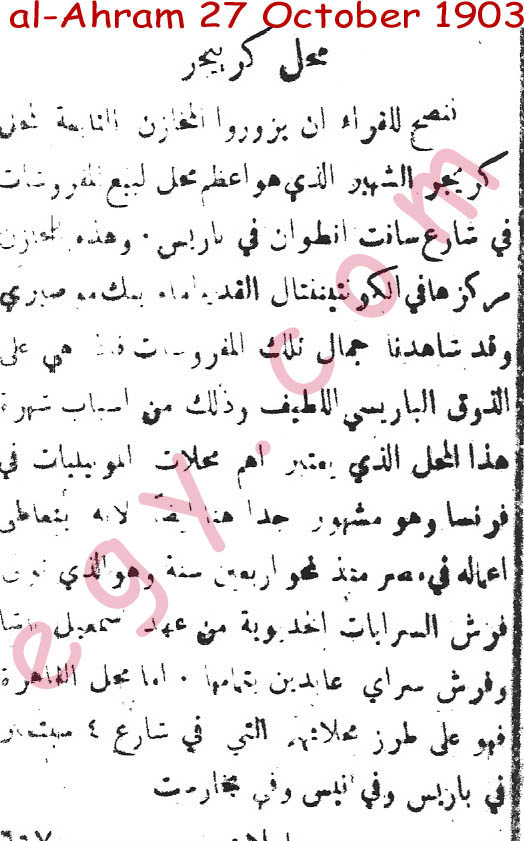
Maison Krieger of 76 Faubourg Saint Antoine, Paris, well-known purveyor of furniture to khedivial palaces since the reign of Ismail Pasha
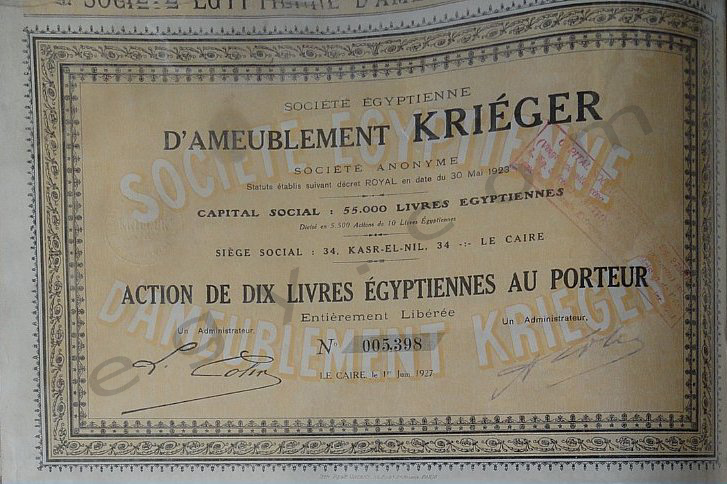
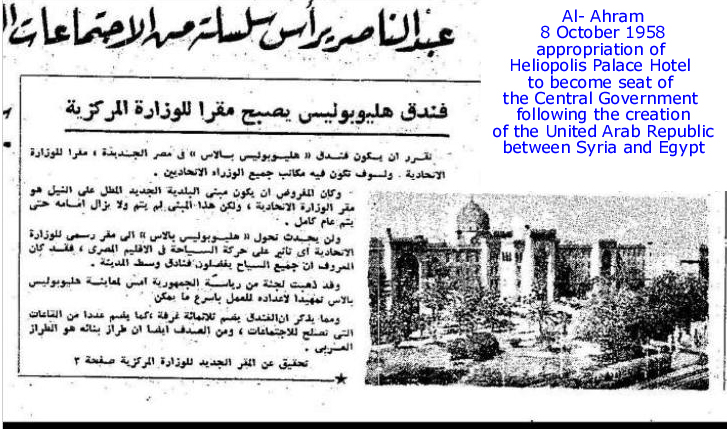
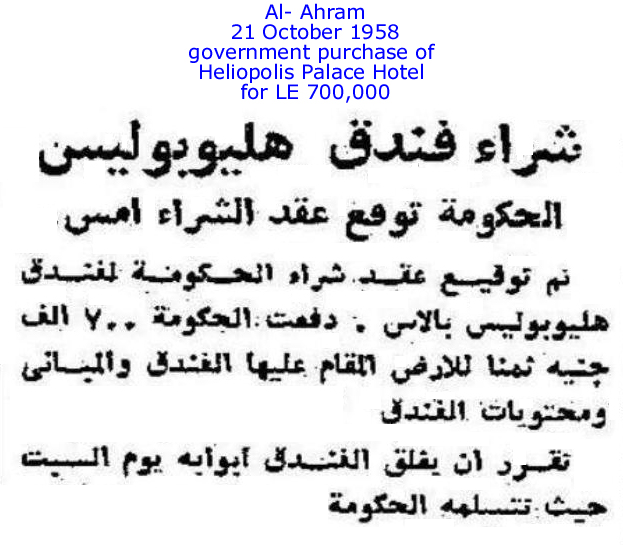
Heliopolis Palace Hotel closes its doors to the public in October 1958
Reader Comments
|
Subject: Heliopolis Palace Hotel
Date: Tue, 27 Jul 2004 21:26:52 +0100
From: Kumalo
Thank you for your fine article on the old palace/hotel. During World War 2 I was stationed there in the RAF and it brought back pleasant memories of my youth. 216 Group RAF was my unit and I was a flying control officer at Aircraft Safety Centre Egypt, (the room was within the Hotel) which provided control and search and rescue for aircraft flying over the huge area from Persia to Italy and south to the Sudan. We were billeted out at various pensions in the surrounding streets, eating at cafes. What a magnificent
building it was! Thank you to Egypt for your hospitality.
DCW, (UK)
Subject: Heliopolis Hotel
Date: Thu, 24 Jun 2004 12:07:47 -0400
From: Oriette Constantineau
I worked for an international air conference held at the Heliopolis Hotel in 1946, October, I believe. I was interested to read your story.
Subject: (no subject)
Date: Sat, 04 Apr 1998 23:47:35 -0500
From: Cherif Robert Raad
Magnifique article sur 'Heliopolis Palace Hotel. I remember as a child going there to assist Horse riding competition, we use to go and play in the gardens of the palace.I remember still the beautifull black marble covering the bathrooms. I appreciate a lot your articles .
|
Email your thoughts to egy.com
© Copyright Samir Raafat
Any commercial use of the data and/or content is prohibited
reproduction of photos from this website strictly forbidden
touts droits reserves






